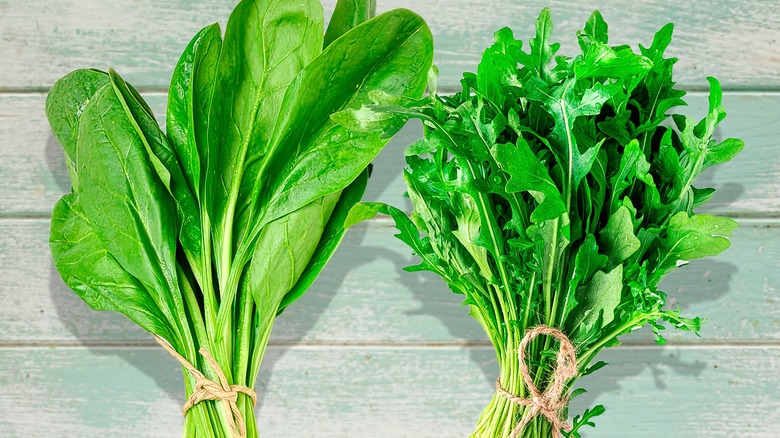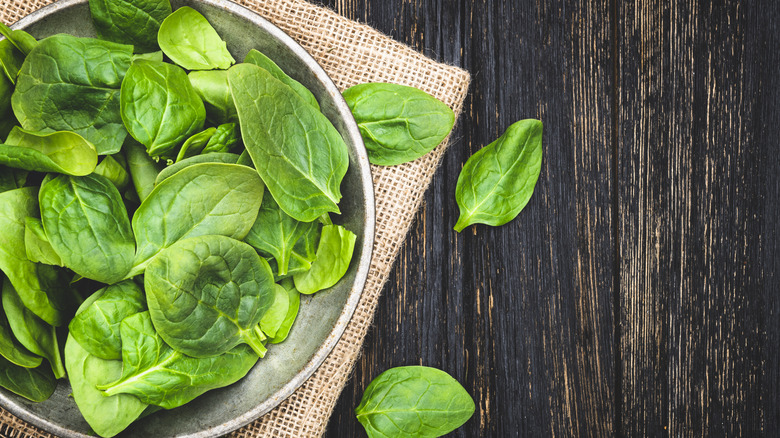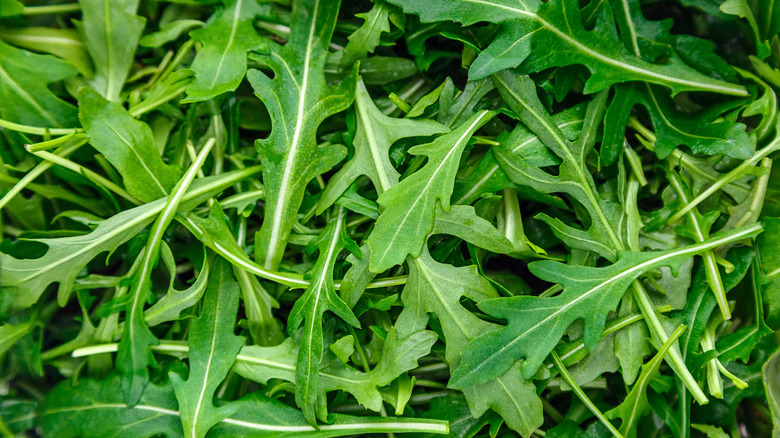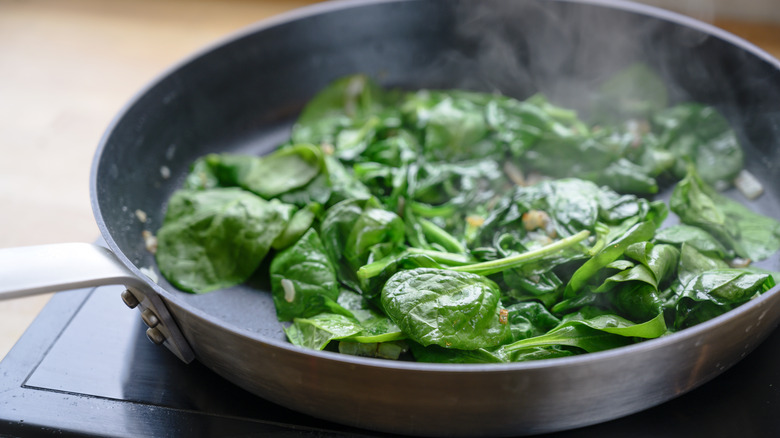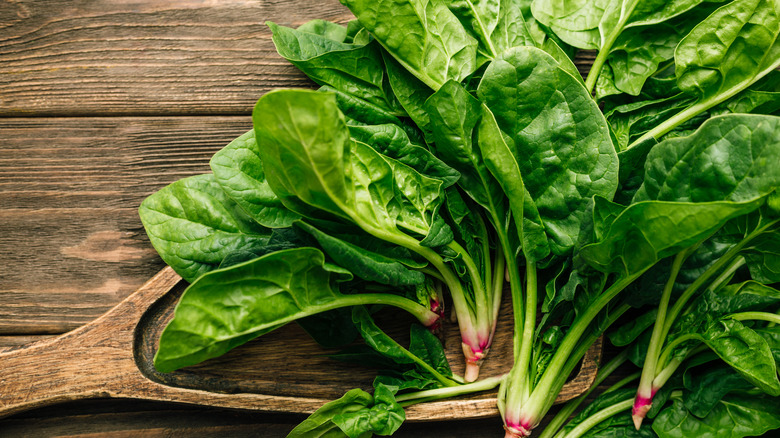Spinach Vs Arugula: The Difference That You Can Taste
Spinach and arugula are two grocery store stalwarts, so much so that they get frequently paired together in products, but with differences that highlight the impressive diversity you have to choose from in leafy greens. Spinach is one of the common green vegetables you'll see across all kinds of dishes, whether it's sauteed as a side with some lemony chicken, or tossed into soups to wilt. Arugula on the other hand has always felt more specialized, something you toss on a wood-fired pizza, or save for a Caprese frittata. But both reputations are only half the story. Spinach isn't just a workhorse you can toss anywhere, but a tender green with a robust, vegetal flavor that can transform dishes. And arugula recipes can be just as versatile and it's just as good cooked as it is raw.
Arugula and spinach are more alike than different, but they won't always work when substituted for each other. Arugula has a little more crunch than the more tender spinach, and while they are both bitter greens, arugula also has a bolder, more unique flavor that will stand out in recipes and salads. And despite both being leafy vegetables, there are some pretty meaningful nutritional differences as well. So despite their salad mix partnership, you don't want to treat spinach and arugula the same. They are each worthy of learning about on their own terms, and figuring out the right spot to highlight their strengths.
What is spinach?
Spinach is a leafy green from the amaranth family, related to beets, quinoa, and Swiss chard. It comes in a variety of different breeds and styles, usually separated into categories of either smooth or crinkly leaves. It's distinguished from other leafy salad greens because its leaves grow from loose stalks, not bunched together in heads like most others. Spinach is available year-round, but it is generally considered a cool-weather vegetable that is best in the transitional seasons of spring and fall. While it has been a popular crop for centuries, it took off in the 20th century because of its high nutritional content, and can now be found fresh, canned, and frozen all over the globe.
The origins of spinach can be traced back to ancient Persia over 2,000 years ago. Spinach was known as the "Persian vegetable," as it spread around the world. Spinach was very popular in the Muslim world, and traders brought it to Spain, Sicily, and the rest of the Mediterranean in the 9th and 10th centuries. It eventually found its way to Northern Europe and is even mentioned in the first English cookbook, Forme of Cury, which dates to 1390. Spinach came over the United States with the earliest colonists, and was popular in America all throughout the 19th century, leading to its appearance in early popular culture like the Popeye cartoons.
What is Arugula?
Like spinach, arugula is a leafy salad green, but it is not related to most lettuce. It's actually a member of the brassica family, making it a relative of broccoli, cabbage, and mustard greens. It's an extremely fast-growing plant, and like spinach, it's at its best in cooler weather in the spring and fall. It's easily identifiable from its signature ridged shape with lots of small points. Arugula is an extremely pungent, strongly flavored green, but it is also sold as younger "baby" arugula in grocery stores, which has a milder flavor.
Arugula is native to the Mediterranean and has been a staple of Italian, French, and Turkish cuisines for centuries. There are records of arugula going back to the 6th century B.C. when it was mentioned in the Old Testament Book of Kings. There are numerous writings about it from the Roman era when it was grown as a medicinal herb and considered an aphrodisiac. Famous writers like the poet Virgil and the naturalist Pliny the Elder mention its connection to physical stimulation in their work, although they do not mention how this association came about. Unlike spinach, which has been consistently popular in the United States, arugula didn't become widely eaten until the rise of higher-end artisanal cooking in the late 20th century, and it has since become a staple of healthy eating diets in America.
Spinach is more mild and vegetal tasting than peppery arugula
If you need clear proof of the huge difference that leafy greens can have in taste, proof they don't all just taste "green," arugula and spinach are perfect examples. Spinach has a more classic vegetal flavor to it. It's generally mild and only a little bitter compared with other greens. There are slight undertones of earthiness and sweetness, it can even be a little minerally. For people who don't like it, it can taste a bit dirt-like, or just generally bland. Cooking with spinach gives it a noticeable jump in flavor. Its subtle flavor also gets a big boost from simple, acidic ingredients like vinegar or lemon juice.
Arugula's signature characteristic is how peppery it is. It has a real bite and could be fairly described as spicy, with a more pronounced bitterness than spinach. You can taste some of that same sinus-clearing punch you get from its relative mustard, or horseradish. That strong flavor is why it is frequently used as a salad green against other strong ingredients like parmesan cheese or used as a topping on sandwiches. However, that peppery kick also makes it more fresh tasting than the savory spinach. Unlike spinach, arugula actually gets milder when cooked, cutting down on the spice.
Arugula has more crunch and texture when raw
While the taste difference between spinach and arugula is obvious on first bite, they feel like they have more similar textures at first, but there are a few ways they differ from each other. When raw, arugula has a bit more crispness to it than the softer spinach. Both are relatively tender, but arugula has a crunch closer to what we expect from salad greens. The stem in particular has a snappy bite that stands out from spinach, and it's thinner in a way that feels lighter when eaten raw.
However, the stronger texture of the arugula gets reversed when the two are cooked. Since spinach is thicker and denser than arugula, it is more hearty and holds up better to cooking. The thinner arugula tends to wilt into mush if exposed to heat for too long, so it's best prepared by adding it right at the end of recipes. Spinach also wilts quickly, but maintains its integrity better, so it can be cooked longer in things like stir-fries, or simmering in your favorite soup recipes.
Spinach is more nutrient dense than arugula
As fresh greens, it shouldn't be shocking that spinach and arugula pack in a lot of good vitamins and minerals, however when put side by side, spinach has a surprisingly clear advantage. Both greens are low in sugar and fat. Spinach does have a small advantage in fiber, about 40% for a 100g serving, but neither are true high-fiber foods, providing a little less than 10% of your daily need in about three raw cups, which cooked down is about ⅓ of a cup.
These greens are both terrific at providing vitamins, and this is also where spinach outpaces arugula. For that same 100g serving spinach provides 56% of your daily vitamin A and 47% of your vitamin C, both of which are important immune-boosting antioxidants. Arugula is also a good source but only has 47% of your Vitamin A and 25% of vitamin C. Spinach also has a whopping 600% of your necessary vitamin K, which aids blood coagulation, while arugula has 136%. Spinach provides almost 50% of your daily folates (vitamin B9), while arugula gets you about 25%.
Finally, spinach is a solid source of minerals as well. One hundred grams of spinach has 15% of your daily iron and potassium, 20% of your magnesium, and 45% of your manganese. Arugula has around 10% of your iron, potassium, and magnesium, and 15% of your manganese. The one place it does outdo spinach is calcium, where arugula has about 50% more and 15% of your daily need.
Arugula and spinach can both be used in a wide array of recipes
With two such versatile vegetables, you can find a plethora of uses both raw and cooked for spinach and arugula, but their differences in taste will change where they are best used. Both are great for salad recipes, but within that world spinach salad tends to do better when it's more dressed up, using creamy dressings that might wilt the lighter arugula, and adding plenty of toppings with more robust flavor to account for spinach's mild taste. Arugula can hold down big, filling salads too, yet it is superior to spinach when it comes to simple side salads with just a few basic additions like olive oil and shaved parmesan, as its peppery kick still gives it plenty of flavor without the need for much embellishment.
Arugula also works great as a topping in its own right, not just on fresh Italian pizzas and sandwiches, but also as a garnish for roasted meat or a chopped sprinkling over roasted veggies and potatoes for a little green boost, just like you might use parsley or cilantro.
If you are cooking, your best bet is usually spinach. Wilt it into soups, bake it into pies, tarts, and quiches, or sautee it for rice bowls and meat, where the heat will amplify its flavor. Arugula will also be nice sauteed as a side, but won't hold up to longer cooking like bakes and stews.
